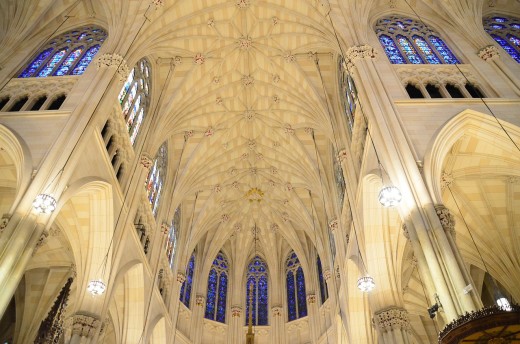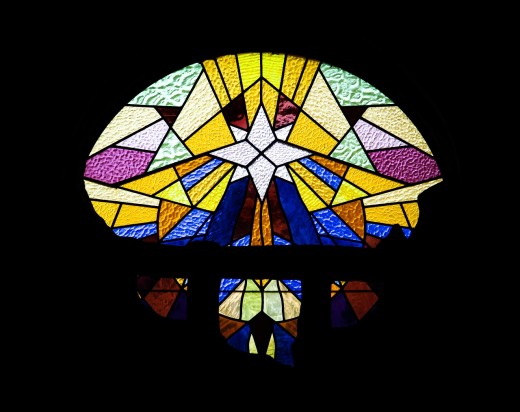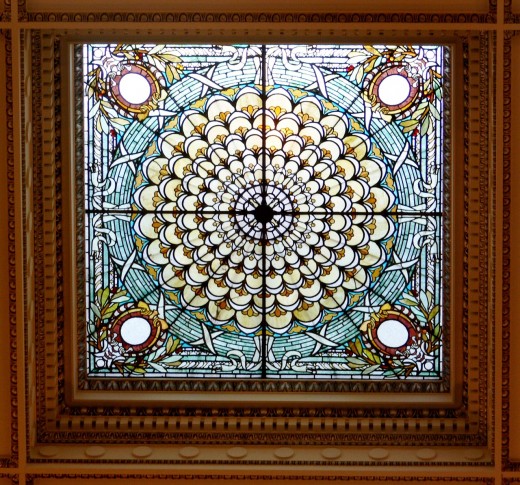Stained Glass Window Beginning to Present Time
There is nothing more beautiful in a room than a stained glass window with the sun shining through,and it seems to bounce the colors as they dance off the glass. In Western Europe the stained glass window constituted the major form of pictorial art that has survived.
The purpose of the window is not to allow people to see outside, or even to admit light, but rather to control it. A stained glass window has been described as figurative; as if man incorporate narratives drawn from the Bible, history or literature. Sometimes they represent patrons or saints. Other times they use symbolic motifs.
During the Renaissance for 300 years stained glass windows were painted, thus traditional stained glass skills were lost. Luckily many of the older windows in cathedrals lasted for centuries. There were several artists using the stained glass with the white paint method during these years, with some events outstanding in history. The innate beauty of true stained glass was forgotten for a time.
Man of Sorrows and Saints
Stained Glass 1300-1480
Saint Louis IX of France (1226-1270), the King, and considered a Saint even during his lifetime. Following his death, 400 people gathered at Saint-Denis to testify to his sanctity. There in the abbey, the Chapel of Saint-Louis was dedicated. Two Grisaille Panels were placed in the chapel. They were made of pot-metal and white glass with silver stain.
Saint Louis built churches and many religious houses in his reign. His royal chapel on the Ile de la Cite in Paris was built to enshrine the relics of Christ’s Passion, which was consecrated on April 26, 1246. It contained a shrine for the Crown of Thorns and a fragment of the True Cross purchased from Emperor Baldwin II of the Latin Empire of Constantinople for the exorbitant sum of 135,00 livres.
In 1480, Marer dolorosa created The Man of Sorrows and the Mater dolorosa, in Strassburger, Werkstattgemeinschaft, Germany was again completed using pot metal and vitreous painting. Peter Hemmel von Andlau and a loose assembly of glass painters in his workshop were commissioned by the dean and chapter of Constance Cathedral to glaze the chapter house. Of the original eighty-one panels, only nineteen have survived.
The Hemmel style has delicately modeled features of the figures round, fleshy face with the exuberance of the drapery in broad planes.
The Adoration of the Magi
Stained Glass - The Cloisters in NYC
Another beautiful piece of stained glass is now located at The Cloisters (in NYC) and titled “Theodosius Arrives at Ephesus”, which was made in Rome about 1200 AD. This scene is straight out of the book of Ephesians in the Bible.
The Man of Sorrows and Theodosius Arrives in Ephesus are presently housed in The Cloisters, which I was fortunate enough to visit in NYC about six years ago. These are just a few of the old master pieces from the Renaissance era.
During the Victorian and Edwardian eras of the 1800’s, stained glass began to be used in non-religious windows of European chateaus. They still only used cathedral type glass, which is a smooth textured glass of various colors. The colors began to change for the traditional bright colors to the soft colors, which were really more appropriate for domestic windows. Stained glass made a major advance in the late 1800's and early 1900s during the Art Nouveau period, when American glass makers expanded upon the European cathedral glass by making a translucent "milky" glass known as opalescent glass. Many sub-types of glass have been developed since that time. In America, stained glass became very popular in the 1960’s and 1970’s. And, as we move forward we are seeing new styles and designs.
Church Stained Glass Window
St. Patrick's Cathedral in New York City

Ceiling of St. Patrick's Cathedral
Some of the outstanding work for more recent artist includes the roof and stained glass of St. Patrick’s Cathedral in New York City. The artists of St. Patrick’s Cathedral are Chartres of France and Birmingham, of England and Boston, Massachusetts. They will not allow you to bring in a tripod for pictures but you may sit in a pew and aim your camera straight up. That's better than no picture at all.
Beautiful Stained Glass Window

Louis Comfort Tiffany- Expert Craftsman
You certainly would have to include Louis Comfort Tiffany. (1848-1933), born in NYC. He was a U.S. painter, craftsman, philanthropist, decorator, and designer and the son of the famous jeweler Charles Louis Tiffany. He studied painting with American painter George Inness in Paris.
He was a recognized painter before he began to experiment with stained glass in 1875. He founded a glass making factory in Queens, N.Y., in 1878. There he developed an iridescent glass he called Favrile, which achieved widespread popularity in Europe. After 1900 Tiffany's firm ventured into lamps, jewelry, pottery, and bibelots. He is internationally recognized as one of the greatest forces of the Art Nouveau. One of his numerous designs is as breathtaking as the next. He is truly an artist that I adore.
Yale University
Wood Framed Stained Glass Window

Frank Lloyd Wright Lighting Lamp

Frank Lloyd Wright
No discussion of recent stained glass and design would be complete without mentioning Frank Lloyd Wright and the huge influence he had on modern design. There is a Frank Lloyd Wright foundation, that displaces his unique designs.
He was born in Richmond Center, Wisconsin (1867-1959), and his dream was to become an architect. He didn’t finish high school but went to work for the Dean of Wisconsin’s Engineering Department.
He completed two year of civil engineering before relocating to Chicago. He worked with architect Joseph Lyman Silsbee and drafted construction on his first building, the Lloyd-Jones family chapel.
He believed that buildings should move away from European design, and he based his work on American functions. He designed more than 1,000 projects which resulted in 500 completed works. He was very innovative with types of design; material used and promoted organic architecture.
He designed interior elements of his architectural projects, as well as, working with stained glass. He tended to use linear designs uniquely different from ones of scenes, people or flowers, I could fill up pages with his numerous designs.
The stained glass windows are loved by many and are frequently used in front doors and in the window beside the front door with a popularity that is certainly not waning.
In Summary
From the Renaissance when glass was painted to modern times, leaded glass has been used in beautiful cathedrals and in people's homes.
If you have an opportunity to see some of Frank Lloyd Wright's work it is stunning and different from what was done in ancient times. Wherever you travel try to visit older cathedrals, and you are usually in for a treat with the spendid beauty of stained glass.
The copyright, renewed in 2018, for this article is owned by Pamela Oglesby. Permission to republish this article in print or online must be granted by the author in writing.
No comments:
Post a Comment